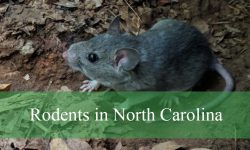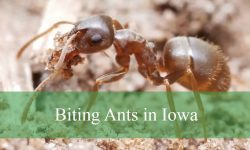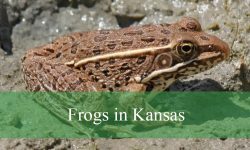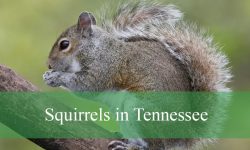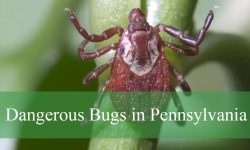Florida is home to many colorful bird species, and red-headed birds are among the most striking. Their bright crimson markings stand out in forests, wetlands, and backyards across the state.
Some of these birds, like the Northern Cardinal and Red-bellied Woodpecker, live in Florida year-round. Others, such as the Redhead Duck and Purple Finch, visit only during the winter months.
This guide introduces 18 beautiful birds with red heads found in Florida, along with their identification, habitats, and the best times to see them.
Types of Birds With Red Heads in Florida
Red-headed Woodpecker (Melanerpes erythrocephalus)
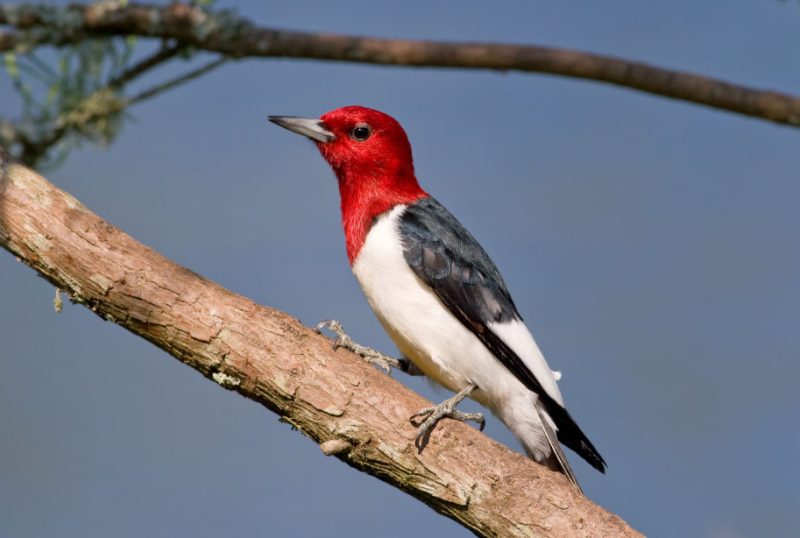
The Red-headed Woodpecker is one of the most striking birds in Florida, easily identified by its entirely crimson head, contrasting with a snow-white body and black wings with white patches. Both males and females look alike, which makes them unique among woodpeckers. Adults typically measure about 7.5 to 9.1 inches in length with a wingspan of 16 to 17 inches.
This bird’s sharp, chisel-like bill is perfect for drilling into trees in search of insects or storing food. Red-headed Woodpeckers are known for their acrobatic flight and habit of catching insects in midair, an uncommon trait among woodpeckers. Their loud, harsh “queer” calls often echo through open forests and wooded farmlands.
They prefer habitats with open woodlands, oak savannas, and forest edges, especially where dead trees are present for nesting. In Florida, they can be found in both rural and suburban areas, particularly in north and central regions.
Red-headed Woodpeckers are omnivores, feeding on insects, nuts, fruits, and even small rodents. They often cache food in tree crevices for later use, covering it with bark or wood chips—a behavior that highlights their intelligence and adaptability.
Northern Cardinal (Cardinalis cardinalis)
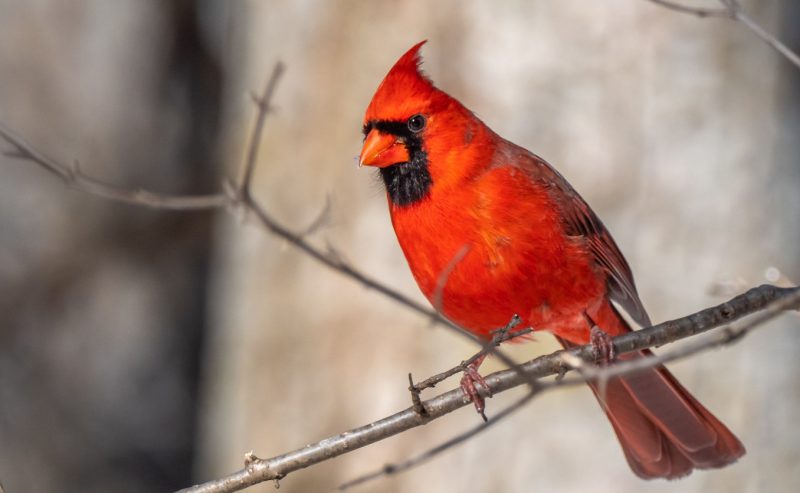
The Northern Cardinal is one of the most familiar red-headed birds in Florida, recognized by its brilliant red plumage and distinctive crest. Males are bright red all over with a black face mask around the bill, while females have a softer tan color with reddish accents. Adults measure about 8.3 to 9.1 inches long with a wingspan near 10 to 12 inches.
Their conical, orange-red bill is well-suited for cracking seeds, which make up most of their diet. Northern Cardinals are year-round residents in Florida and are often heard singing clear, whistling phrases such as “cheer-cheer-cheer.” Their songs help mark territory and strengthen pair bonds.
They thrive in habitats such as suburban gardens, forest edges, parks, and thickets. Cardinals are often seen perched in shrubs or near bird feeders, especially those stocked with sunflower seeds. They are non-migratory and maintain the same territories throughout the year.
Cardinals are monogamous, and both parents share duties in feeding chicks. Their bright coloration and cheerful songs make them a favorite among Florida birdwatchers, symbolizing warmth and vitality in any backyard.
House Finch (Haemorhous mexicanus)
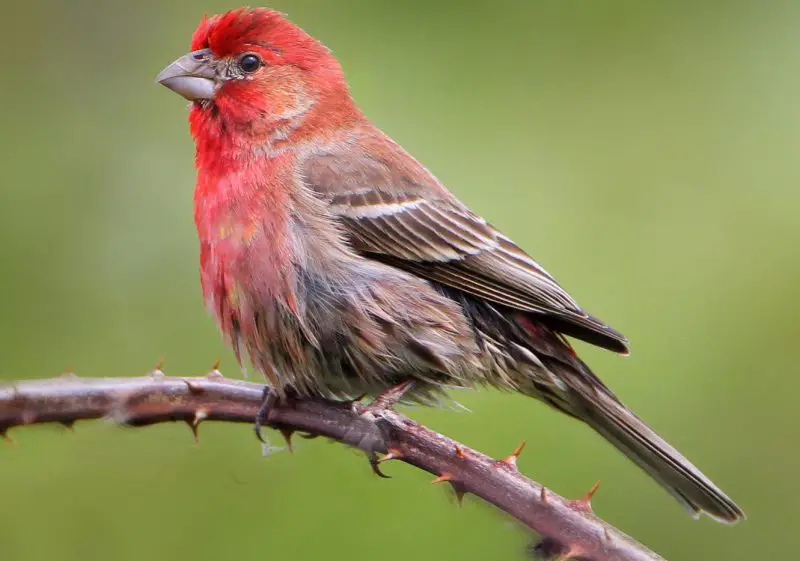
The House Finch is a small, social bird that brings a splash of red to Florida’s cities and neighborhoods. Males have rosy-red heads, throats, and chests, while females are brown and streaked without red. Adult House Finches typically measure 5 to 6 inches long with a wingspan of 8 to 10 inches.
Their rounded heads, short tails, and slightly curved bills make them easy to identify among backyard birds. The intensity of the male’s red coloring depends on diet quality, especially the amount of carotenoid pigments in the food they eat. This makes them an interesting example of diet influencing plumage.
They are commonly found in urban and suburban areas, often nesting in hanging planters, eaves, and streetlamps. In Florida, they are year-round residents, comfortable around human activity and often visiting feeders.
House Finches primarily eat seeds, grains, and fruits, and their cheerful, warbling songs are a common sound in Florida neighborhoods. They gather in flocks, showing friendly behavior that contrasts with more territorial bird species.
Pileated Woodpecker (Dryocopus pileatus)
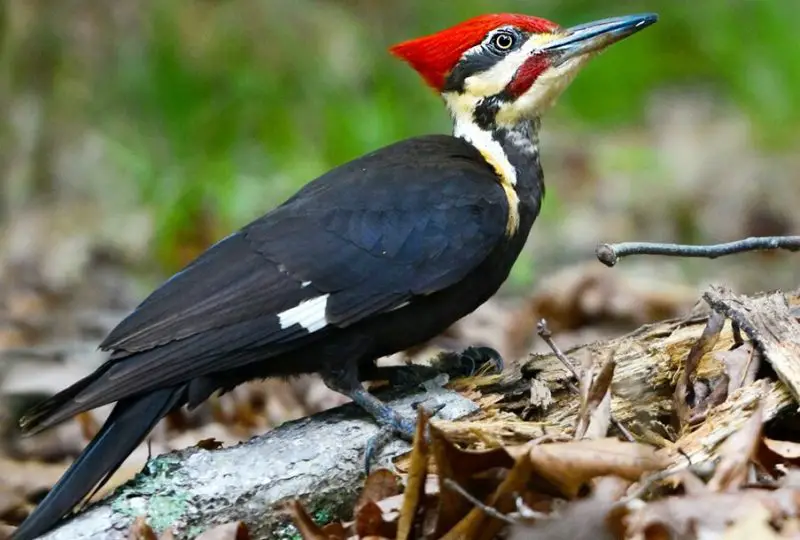
The Pileated Woodpecker is the largest woodpecker species in Florida and one of the most spectacular birds in North America. It has a striking red crest on its head, black body, white neck stripes, and white underwings visible in flight. Adults can reach lengths of 16 to 19 inches with wingspans up to 30 inches.
These powerful birds use their strong bills to excavate large rectangular holes in trees while searching for carpenter ants and beetle larvae. The drumming sound they make can be heard echoing through forests from a great distance. Their loud “kuk-kuk-kuk” calls are another giveaway to their presence.
Pileated Woodpeckers prefer mature forests, wooded swamps, and pine habitats across Florida. They require large, dead trees for nesting and foraging, making them indicators of healthy woodland ecosystems.
Their nesting cavities also benefit other wildlife, such as owls and small mammals, once abandoned. Watching a Pileated Woodpecker in action is a treat for birders, as their powerful strikes and bright crests create a dramatic display in Florida’s forests.
Red-bellied Woodpecker (Melanerpes carolinus)
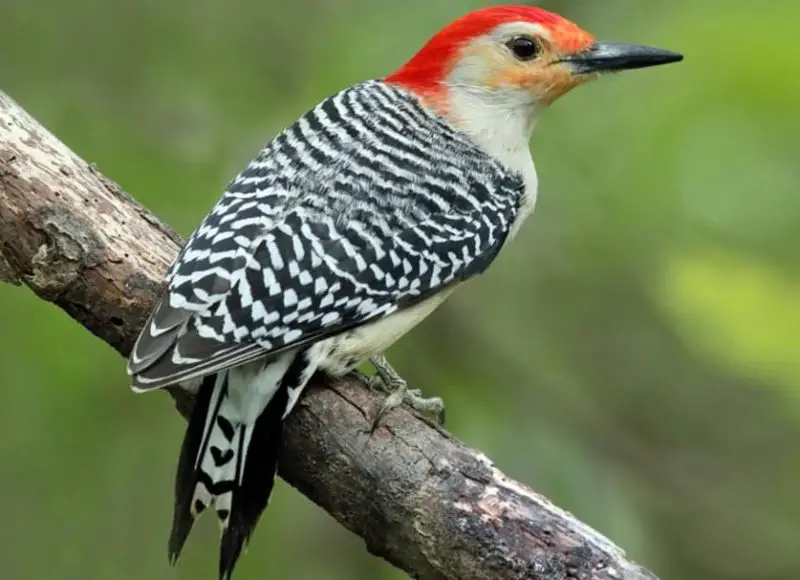
The Red-bellied Woodpecker is one of the most common woodpeckers in Florida and is easily recognized by its red cap that extends from the nape to the crown, black-and-white barred back, and pale underparts. Despite its name, the red on its belly is faint and often hidden. Adults measure 9 to 10.5 inches in length with wingspans around 13 to 17 inches.
They are agile climbers that move up and around tree trunks, probing for insects with their long, sticky tongues. Their rolling “churr” calls are often heard before they are seen, especially in wooded residential areas.
Red-bellied Woodpeckers inhabit forests, suburban yards, and wetlands throughout Florida. They adapt well to human presence, often nesting in dead trees or even wooden fence posts. They play an important ecological role by controlling insect populations.
Their diet is diverse—ranging from beetles and ants to fruits, nuts, and seeds. During winter, they frequently visit suet feeders. Curious and intelligent, the Red-bellied Woodpecker has become a favorite among birdwatchers for its vivid coloration and energetic personality.
Purple Finch (Haemorhous purpureus)
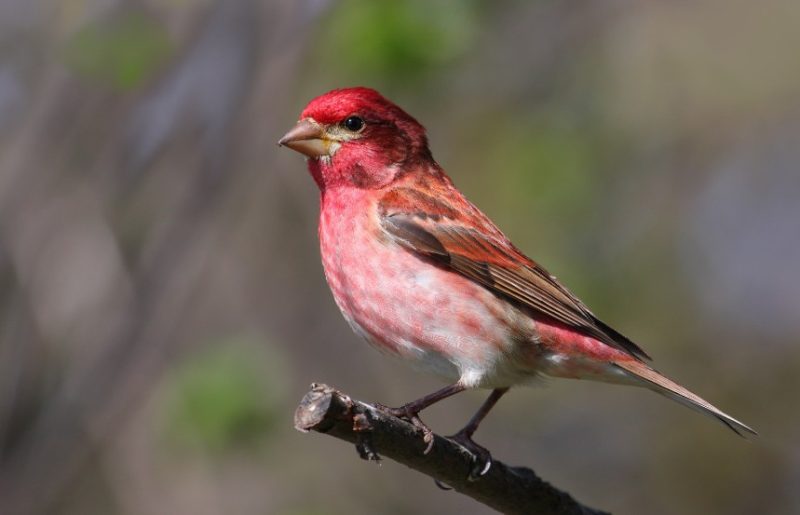
The Purple Finch is a winter visitor to Florida, admired for its rich raspberry-red plumage that gives it a soft, washed appearance. Males are rosy-red on the head, breast, and back, fading into brown wings and tail, while females display brown streaking and a whitish eyebrow. They measure about 5.5 to 6.3 inches long with a wingspan of 8.5 to 10 inches.
Their short, conical bills are perfect for cracking open seeds and buds. Purple Finches are often confused with House Finches, but their coloring is more even and lacks the brownish tones. Their sweet, warbling song adds liveliness to Florida’s winter soundscape.
These finches favor coniferous and mixed woodlands but readily visit feeders in suburban areas, particularly during cooler months. They are nomadic, moving southward into Florida when northern food sources become scarce.
Their diet includes seeds, berries, and insects. At feeders, they prefer sunflower seeds. The Purple Finch’s arrival marks a seasonal highlight for birdwatchers in northern and central Florida, bringing a splash of red during the cooler months.
Summer Tanager (Piranga rubra)
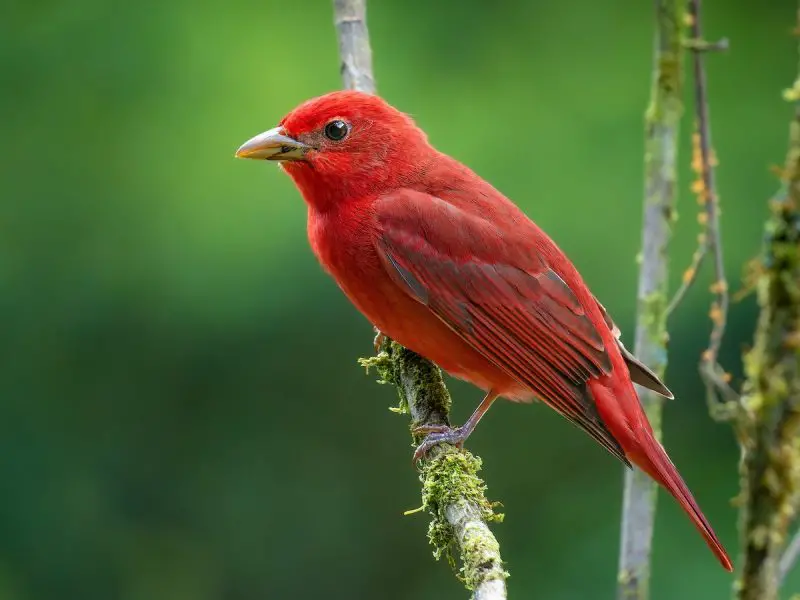
The Summer Tanager is a brilliant red songbird that visits Florida during its breeding season. Adult males are completely red, while females and young birds are yellowish or olive. They are medium-sized, about 6.5 to 7 inches long with a wingspan close to 11 inches.
This bird is known as the only completely red bird in North America. Its stout bill is well-suited for catching and crushing bees and wasps, which form a significant part of its diet. They also eat fruits and other insects, often foraging high in tree canopies.
Summer Tanagers breed in open woodlands, forest edges, and riparian zones throughout Florida, particularly in northern and central regions. They prefer areas with scattered tall trees and light undergrowth.
Their mellow, melodic songs resemble those of the American Robin. During migration, they travel as far south as South America. In Florida, their vibrant color and peaceful song make them a beautiful sign of summer’s arrival.
Scarlet Tanager (Piranga olivacea)
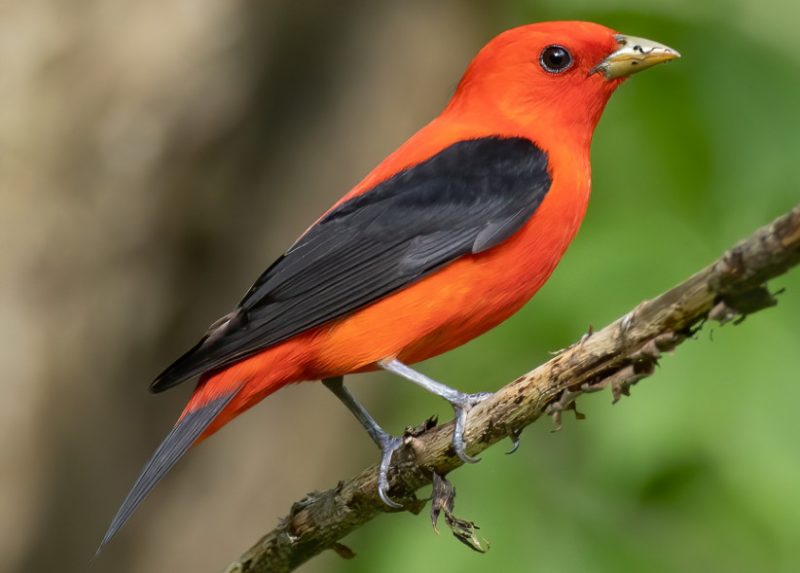
The Scarlet Tanager is one of Florida’s most striking migratory visitors, known for its scarlet body and jet-black wings and tail. Females and juveniles are yellow-green, offering a sharp contrast to the bright males. Adults measure about 6.3 to 7.5 inches long with wingspans around 10 to 12 inches.
Scarlet Tanagers are often hidden in dense forest canopies, making them easier to hear than see. Their song is a series of burry notes, often compared to a robin with a sore throat. Their beauty and elusive nature make them a prized sighting among bird enthusiasts.
These tanagers migrate through Florida during spring and fall, using the state’s woodlands as stopover sites. They prefer mature deciduous forests and large parks with abundant insect activity.
Their diet includes beetles, caterpillars, ants, and fruits. While only passing through, Scarlet Tanagers play a vital role in controlling insects and spreading seeds during migration. Their vibrant coloration adds a flash of tropical brilliance to Florida’s forests.
Vermilion Flycatcher (Pyrocephalus rubinus)
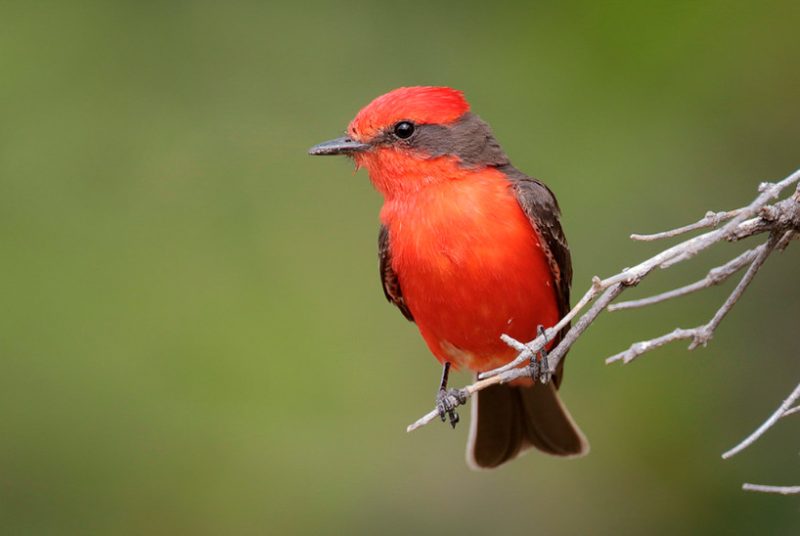
The Vermilion Flycatcher is a rare but dazzling winter visitor in Florida, instantly recognizable by the male’s fiery red body and dark brown mask and wings. Females and young birds are grayish with peach-colored underparts. They typically measure 5.1 to 5.5 inches long with a wingspan around 9.5 inches.
These birds are agile insect hunters, often seen perching on low branches before darting out to catch flying insects midair. Their flight displays are quick and graceful, showcasing their aerial skill.
In Florida, Vermilion Flycatchers are most often spotted in open habitats such as pastures, wetlands, and the edges of coastal prairies—especially in the southern and central parts of the state. They prefer areas with scattered shrubs and low perches for hunting.
Though uncommon, their bright coloration and energetic behavior make them unforgettable sightings during Florida’s mild winter months. Birdwatchers treasure these moments as the Vermilion Flycatcher adds a vivid splash of red to the landscape.
Ruby-throated Hummingbird (Archilochus colubris)
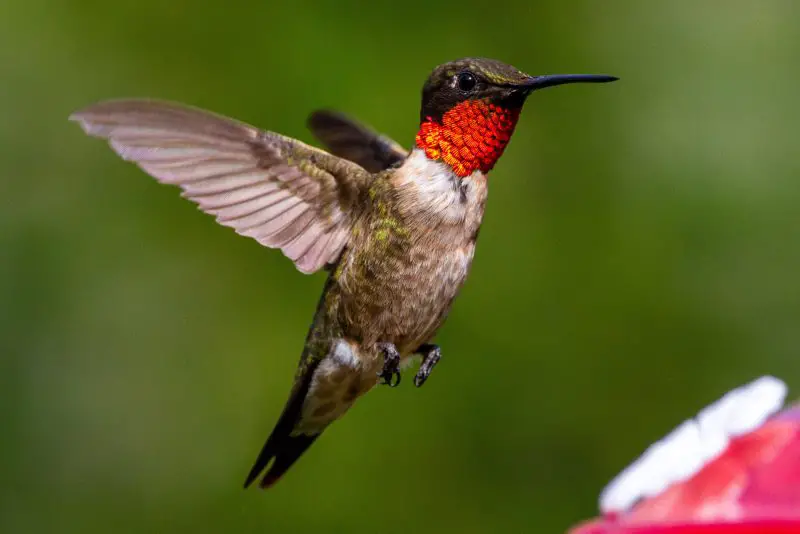
The Ruby-throated Hummingbird is Florida’s most familiar hummingbird, famous for the male’s shimmering ruby-red throat that gleams in sunlight. Females lack the red coloring and are greenish above with white underparts. They measure only 3 to 3.5 inches long with a wingspan around 4 inches, weighing less than a penny.
Their slender, curved bills and specialized tongues allow them to sip nectar from flowers with remarkable precision. Ruby-throated Hummingbirds also feed on small insects for protein, especially during breeding and migration periods.
They inhabit gardens, forest edges, and meadows throughout Florida, particularly during spring and fall migration. Some remain in southern Florida year-round, while others continue to Central America for the winter.
With rapid wingbeats—up to 50 per second—they hover effortlessly while feeding on blossoms such as hibiscus and coral honeysuckle. These tiny birds bring vibrant energy to Florida’s landscapes, symbolizing resilience and grace in motion.
Red-crowned Parrot (Amazona viridigenalis)
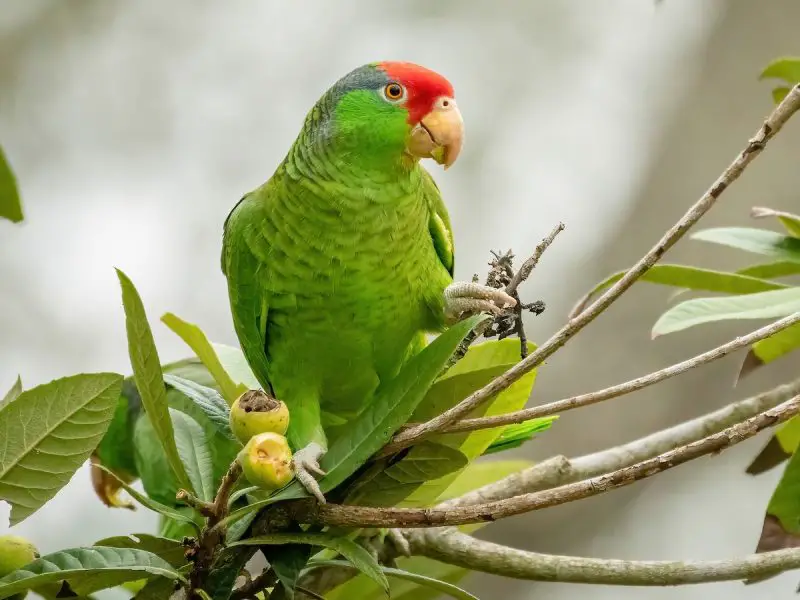
The Red-crowned Parrot, also known as the Green-cheeked Amazon, is a vibrant bird native to northeastern Mexico but now established in parts of southern Florida as a result of escaped or released pets. Adults have bright green plumage with a distinctive red patch on the forehead and crown, along with blue highlights on the wings. They typically measure 12 to 13 inches in length.
These parrots are known for their intelligence, strong social bonds, and loud, raucous calls that can be heard from afar. Their hooked beaks are powerful enough to crack open nuts and seeds, while their zygodactyl feet help them grasp branches and food with precision.
In Florida, Red-crowned Parrots are mainly found in Miami-Dade and Broward counties, where they thrive in suburban neighborhoods, parks, and palm-filled streets. They roost communally in large flocks, often alongside other naturalized parrot species.
Their diet includes fruits, seeds, flowers, and buds. Although considered non-native, these parrots have adapted well to Florida’s climate, forming small but stable populations that add a tropical flair to the region’s birdlife.
Redhead Duck (Aythya americana)
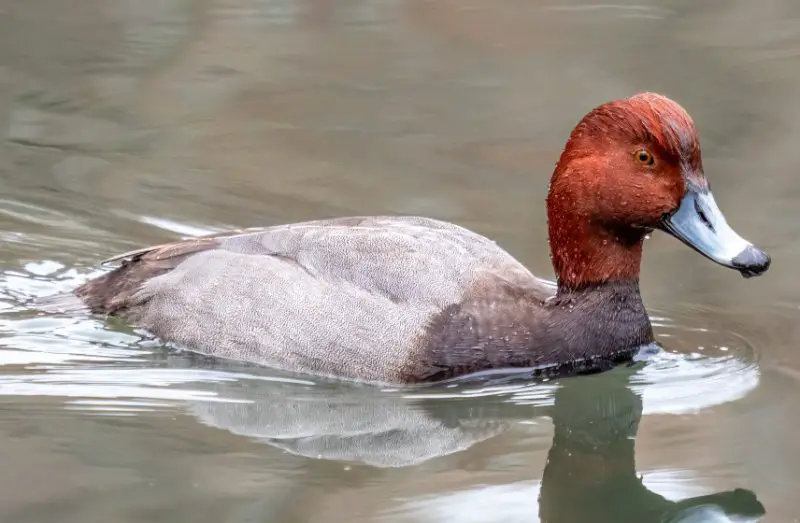
The Redhead Duck is a medium-sized diving duck frequently spotted on Florida’s lakes, marshes, and coastal lagoons during winter. Males are unmistakable with their cinnamon-red heads, black chests, and gray bodies, while females are brown and softly marked. Adults measure 18 to 22 inches long with wingspans around 30 inches.
Redheads are graceful swimmers and divers, often seen floating in large rafts on calm waters. Their broad bills and strong legs are adapted for underwater foraging. They typically dive for aquatic plants, seeds, and small invertebrates.
In Florida, they are winter visitors, favoring freshwater wetlands and coastal bays from the Panhandle to the Everglades. They are most numerous in central and southern parts of the state during migration.
Redhead Ducks are social birds that often mix with other diving species like Canvasbacks and Scaups. Their gentle demeanor and rich coloring make them a highlight of Florida’s winter birding season.
Cassin’s Finch (Haemorhous cassinii)
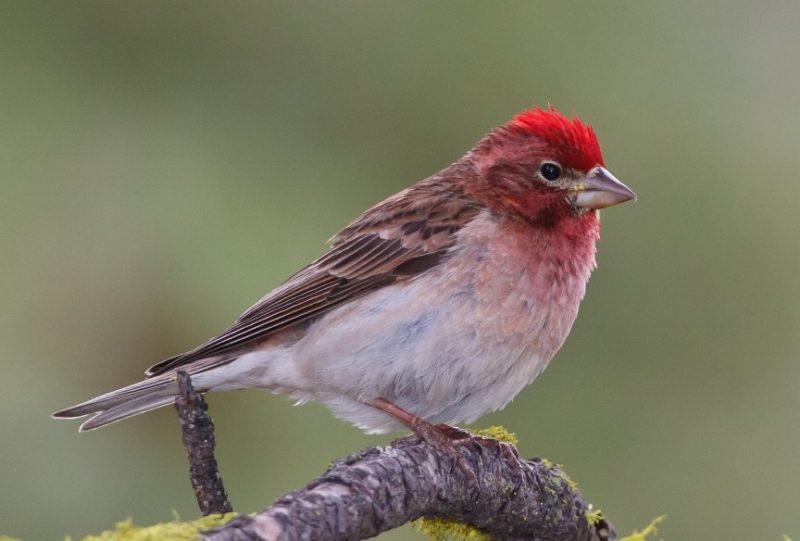
Cassin’s Finch is a rare vagrant in Florida, native to the mountainous forests of the western United States. Males are rose-red on the head, throat, and upper breast, fading into brown-streaked backs and wings. Females and juveniles are brown and heavily streaked, lacking any red coloration. They are about 6 inches long with an average wingspan of 9.5 inches.
These finches are known for their sweet, warbling songs that echo through pine forests. Their sturdy bills are ideal for cracking seeds and picking at buds and berries. They are closely related to the Purple Finch but tend to appear slightly larger and longer-winged.
Although not common in Florida, Cassin’s Finch occasionally appears during unusual migration events or after being displaced by harsh weather. Birders consider such sightings rare and remarkable.
Their natural diet consists of seeds, buds, and small insects. In their typical range, they inhabit coniferous forests, but when they wander to Florida, they are usually found near feeders stocked with sunflower seeds.
Painted Bunting (Passerina ciris)
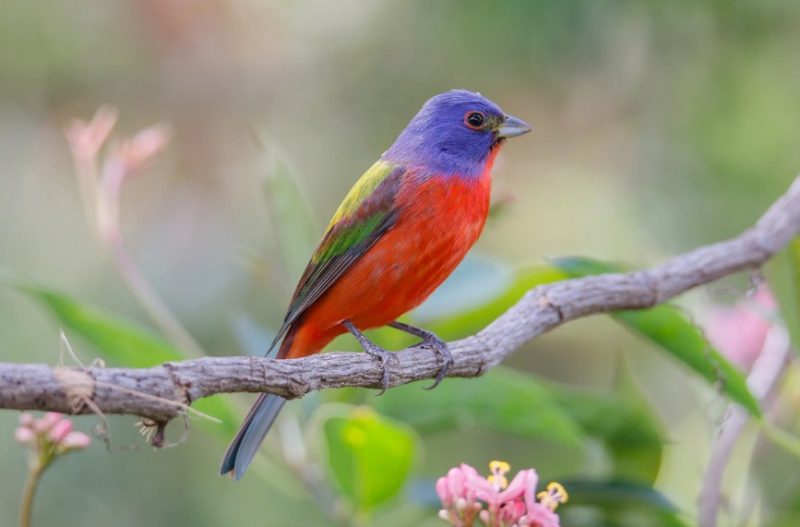
The Painted Bunting is one of Florida’s most dazzling birds, often called the “nonpareil” or “bird without equal” for its extraordinary coloration. Males display a red head and underparts, blue head, and green back, while females are a soft lime-green all over. Adults measure around 5 to 5.5 inches long with a wingspan of 8 to 9 inches.
Males are territorial and often sing brightly from exposed perches during breeding season. Their clear, musical songs and rainbow-like plumage make them a sought-after species among birdwatchers. Females and juveniles are more secretive, blending into dense vegetation.
Painted Buntings are common in Florida’s coastal scrub, woodland edges, and backyard feeders, especially during winter and migration. They breed mainly in northern and central Florida but can be found year-round in the southern part of the state.
Their diet includes seeds, small insects, and fruits. They frequent feeders with millet or nyjer seeds. The Painted Bunting’s vivid colors and lively nature add a touch of brilliance to Florida’s birdlife, embodying the tropical beauty of the region.
Red-cockaded Woodpecker (Leuconotopicus borealis)
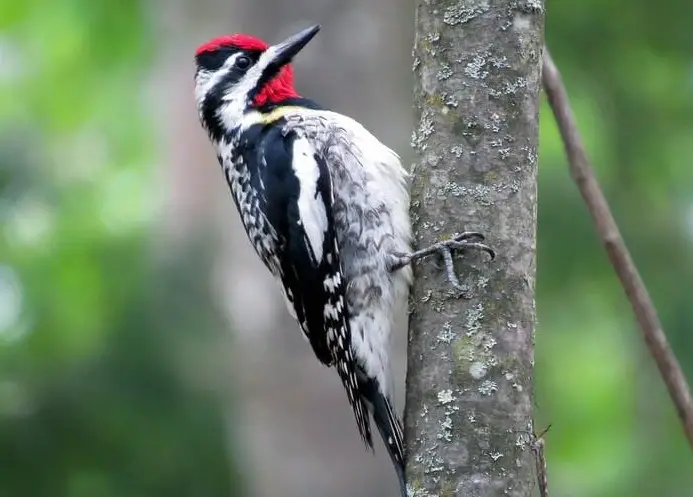
The Red-cockaded Woodpecker is an endangered species native to Florida’s longleaf pine forests. It has a striking black-and-white barred back, white cheeks, and a small red streak (or “cockade”) behind the male’s eye, which can be hard to spot. Adults measure about 7 to 8 inches long with a wingspan of 14 inches.
This small woodpecker is unique because it excavates its nesting cavities exclusively in living pine trees, especially those infected with red heart fungus, which softens the wood. Their quiet tapping and sharp “sklit” calls can often be heard in open pine habitats.
They live in family groups called “clans,” with one breeding pair and several helpers assisting in raising chicks. This cooperative breeding behavior makes them ecologically fascinating and socially complex.
In Florida, Red-cockaded Woodpeckers are found primarily in protected areas such as Apalachicola National Forest and Osceola National Forest. Conservation programs focusing on controlled burns and pine restoration are critical to their survival.
Yellow-bellied Sapsucker (Sphyrapicus varius)
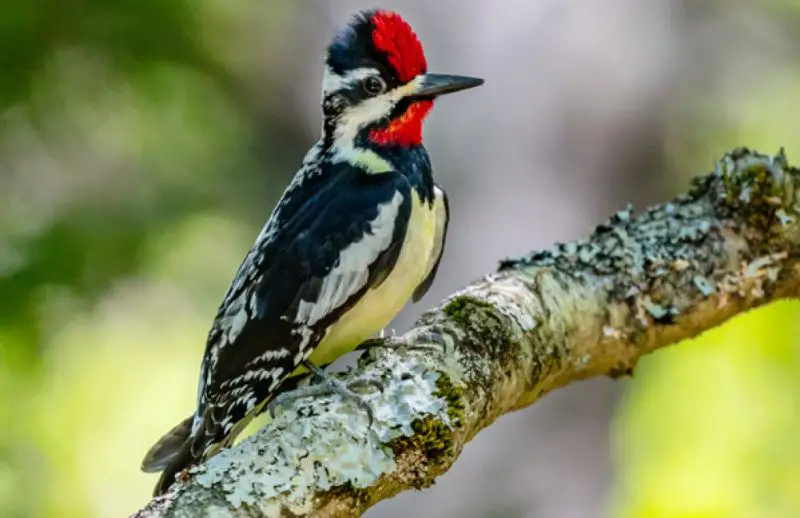
The Yellow-bellied Sapsucker is a migratory woodpecker commonly seen in Florida during the winter months. It features a red forehead, black-and-white striped face, and a pale yellow belly. Males also have a red throat, while females have a white one. Adults range from 7 to 8.5 inches in length with wingspans near 14 inches.
This bird is best known for drilling neat rows of holes in tree bark to feed on sap and trapped insects. They favor trees such as birch, maple, and pine. Their rhythmic tapping and distinct calls often reveal their presence before they are seen.
In Florida, they inhabit woodlands, orchards, and suburban areas from late fall to early spring. Their sap wells also attract other species such as hummingbirds and warblers, benefiting the broader ecosystem.
The Yellow-bellied Sapsucker’s migratory patterns bring it to Florida every year, adding color and activity to winter woodlands. Despite its name, this bird is a skilled and essential player in forest ecology.
Roseate Spoonbill (Platalea ajaja)
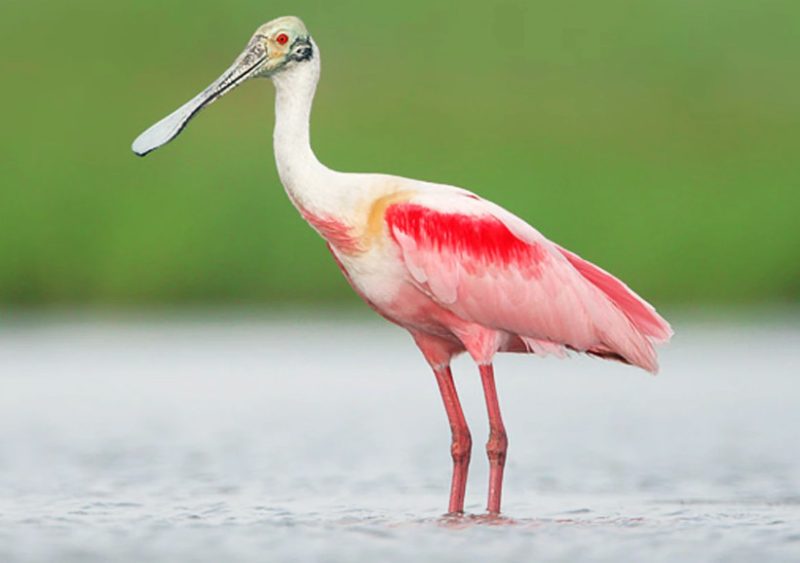
The Roseate Spoonbill is one of Florida’s most iconic wading birds, easily recognized by its vivid pink plumage and unique spoon-shaped bill. During the breeding season, the head may appear reddish or flushed, adding to its striking appearance. Adults reach about 28 to 34 inches in length with wingspans up to 50 inches.
This elegant bird sweeps its long bill side-to-side through shallow water to catch small fish, crustaceans, and insects. The pink coloration comes from carotenoid pigments in its diet, similar to flamingos.
Roseate Spoonbills inhabit coastal marshes, mangroves, and estuaries throughout southern and central Florida. They are especially abundant in the Everglades and along the Gulf Coast.
Their social nature leads them to forage and nest in colonies with other wading birds like herons and egrets. Watching a flock of Roseate Spoonbills feeding in shimmering light is one of Florida’s most breathtaking wildlife experiences.
Common Redpoll (Acanthis flammea)
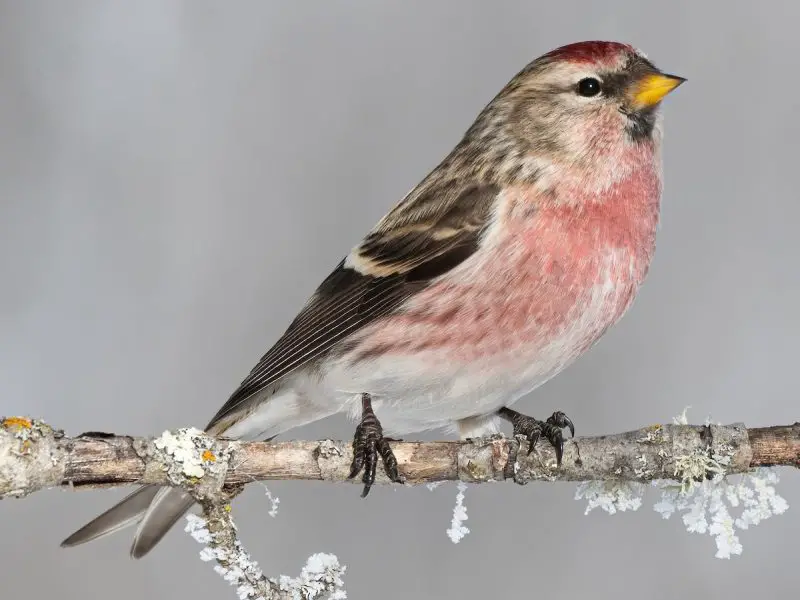
The Common Redpoll is a tiny, energetic finch that rarely visits Florida, appearing only during exceptional winter irruptions. It is easily recognized by its red cap, black chin patch, and streaked brown and white plumage. Adults are around 5 inches long with a wingspan of about 8.5 inches.
These hardy northern birds are built for cold climates, capable of surviving subzero temperatures. Their small, conical bills and energetic movements make them excellent seed foragers. When they do appear in Florida, it’s usually at feeders during very cold winters.
Redpolls are highly social, often seen in flocks that chatter constantly while feeding. They have a distinctive rolling call that adds charm to their lively nature.
Their diet includes birch and alder seeds, buds, and insects. Because they are so rare in Florida, sightings are exciting events for local birdwatchers, marking a special winter occurrence from the far north.
Best Time and Places to See Red-Headed Birds in Florida
Florida’s warm climate and diverse ecosystems make it an exceptional state for spotting birds with red heads year-round. The best time to see most red-headed species depends on whether they are residents or migratory visitors. From November through March, birders can find winter visitors such as the Redhead Duck, Purple Finch, Red-breasted Merganser, and Yellow-bellied Sapsucker. Spring through early summer (April to June) is prime for breeding species like the Summer Tanager, Red-headed Woodpecker, and Northern Cardinal, whose vibrant plumage is most vivid during the nesting season.
The southern and central regions of Florida, including Everglades National Park, Corkscrew Swamp Sanctuary, and Merritt Island National Wildlife Refuge, are excellent places to observe species such as the Roseate Spoonbill and Red-crowned Parrot. In northern Florida, pine forests and longleaf habitats like Apalachicola National Forest are the best locations to spot rarer species such as the Red-cockaded Woodpecker. For urban birdwatching, city parks, gardens, and backyard feeders in Miami, Tampa, and Orlando attract cardinals, finches, and woodpeckers year-round.
Early morning is the optimal time for birdwatching, especially during spring migration when songbirds are most active and vocal. During winter, cooler mornings and late afternoons provide comfortable conditions for observing waterfowl along coastal lagoons and marshes. Bringing binoculars, a field guide, and patience ensures a rewarding experience while exploring Florida’s colorful birdlife.
Birdwatching Tips for Spotting Red-Headed Birds
1. Choose the right habitat: Different species prefer specific environments. Visit pine forests for woodpeckers, coastal lagoons for ducks and grebes, and suburban parks for finches and cardinals.
2. Bring binoculars and a camera: A good pair of 8×42 binoculars helps you see plumage details, while a telephoto lens captures vivid reds without disturbing the birds.
3. Listen for calls: Many red-headed birds—such as woodpeckers and tanagers—are easier to hear than see. Learn their distinctive calls and drumming patterns to locate them.
4. Use bird feeders wisely: Offer black oil sunflower seeds, suet, or millet to attract cardinals, finches, and woodpeckers. Keep feeders clean and place them near shrubs or trees for safety.
5. Stay still and patient: Birds are sensitive to movement. Blend into the surroundings, wear muted colors, and move slowly. Early mornings offer the best light and bird activity.
6. Track migration timing: Use birding apps or eBird checklists to know when migratory species like the Scarlet Tanager or Purple Finch are passing through Florida.
FAQs About Red-Headed Birds in Florida
Why do some birds have red heads?
Red plumage comes from carotenoid pigments in their diet, often obtained from fruits and insects. Bright red coloring signals health and fitness, especially during breeding season.
Are all red-headed birds male?
Not always. In many species, males display vivid red plumage to attract mates, like the Northern Cardinal. However, in species such as the Red-headed Woodpecker, both sexes share similar coloration.
Where can I see the Roseate Spoonbill in Florida?
The Roseate Spoonbill is commonly found in southern and coastal Florida, especially around the Everglades, Sanibel Island, and Merritt Island. Look for them in shallow marshes and mangrove estuaries.
Are any red-headed birds endangered in Florida?
Yes. The Red-cockaded Woodpecker is listed as endangered due to habitat loss in longleaf pine forests. Conservation and controlled burning are helping preserve its population.
What is the rarest red-headed bird in Florida?
The Cassin’s Finch and Common Redpoll are extremely rare winter visitors. They appear only during unusual cold-weather migrations from northern regions.
Can I attract red-headed birds to my backyard?
Yes. Plant native shrubs, add seed and suet feeders, and provide clean water sources. Common backyard visitors include the House Finch, Northern Cardinal, and Red-bellied Woodpecker.
Do red-headed birds stay in Florida all year?
Some, like the Northern Cardinal and Red-bellied Woodpecker, are permanent residents. Others, such as the Scarlet Tanager and Redhead Duck, migrate seasonally.
What is the best time of day for photography?
Early morning and late afternoon offer soft, golden light that enhances red feathers. Birds are also most active during these cooler times of day.
Are parrots like the Red-crowned Parrot native to Florida?
No. The Red-crowned Parrot originated from escaped or released pets but now maintains stable wild populations in southern Florida, particularly in the Miami area.
What should I do if I spot a rare red-headed bird?
Take a clear photo, note the location, and report the sighting to eBird or local birding groups. Your observation helps researchers monitor migration and population trends.

